Eleven Years of Mangrove–Mudflat Dynamics on the Mud Volcano-Induced Prograding Delta in East Java, Indonesia: Integrating UAV and Satellite Imagery
Abstract
1. Introduction
2. Materials and Methods
2.1. Study Area
2.2. UAV Data Collection and Processing
2.2.1. Data Acquisition
2.2.2. Data Processing
2.2.3. Tree Detection Validation
2.3. Satellite Data and Processing
2.3.1. Available Dataset
2.3.2. Vegetation Indices
2.3.3. Land Cover Classification
2.3.4. Accuracy Assessment and Validation
3. Results
3.1. Point Clouds
3.2. Canopy Height Model (CHM) and Tree Detection
3.3. Mangrove Extent and Age Estimation
3.3.1. Mangrove Extent
3.3.2. Accuracy Assessment of Porong’s Mangrove Classification
3.3.3. Age Map
4. Discussion
4.1. UAV-Based Mangrove Forest Inventory
4.2. Mangrove Belt Expansion Identification in Google Earth Engine
4.3. Seasonal Pattern of Mangrove Dynamics
4.4. Mangroves’ Age Class Estimation
4.5. Implications of the Study
5. Conclusions
Supplementary Materials
Author Contributions
Funding
Data Availability Statement
Acknowledgments
Conflicts of Interest
Appendix A
| Steps | Parameters | Value |
|---|---|---|
| Align Photos | Accuracy | ‘High’ |
| Generic Preselection | ‘Yes’ | |
| Reference Preselection | ‘Source’ | |
| Key Point Limit | 50,000 | |
| Tie Point Limit | 4000 | |
| Guided Image Matching | ‘Yes’ | |
| Adaptive Camera Model Fitting | “Yes” | |
| Camera Calibration | ‘Enable Rolling Shutter Compensation’ | |
| Dense Cloud Generation | Quality | ‘High’ |
| Depth Filtering | ‘Mild’ | |
| Calculate Point Colours | activate | |
| Calculate Point Confidence | activate |
Appendix B
| Plots | RMSEx | RMSEy | RMSEr |
|---|---|---|---|
| Observer 1 | |||
| North 1 | 0.09 | 0.09 | 0.12 |
| North 2 | 0.07 | 0.08 | 0.11 |
| North 3 | 0.08 | 0.09 | 0.12 |
| South 1 | 0.19 | 0.16 | 0.25 |
| South 2 | 0.13 | 0.08 | 0.15 |
| South 3 | 0.09 | 0.08 | 0.12 |
| Average | - | - | 0.15 |
| Observer 2 | |||
| North 1 | 0.12 | 0.09 | 0.15 |
| North 2 | 0.11 | 0.10 | 0.15 |
| North 3 | 0.08 | 0.08 | 0.11 |
| South 1 | 0.29 | 0.29 | 0.41 |
| South 2 | 0.28 | 0.26 | 0.38 |
| South 3 | 0.30 | 0.38 | 0.49 |
| Average | - | - | 0.28 |
| Observer 3 | |||
| North 1 | 0.15 | 0.12 | 0.19 |
| North 2 | 0.14 | 0.19 | 0.23 |
| North 3 | 0.15 | 0.15 | 0.21 |
| South 1 | 0.17 | 0.22 | 0.28 |
| South 2 | 0.28 | 0.23 | 0.37 |
| South 3 | 0.14 | 0.16 | 0.21 |
| Average | - | - | 0.25 |
References
- Spalding, M.; Kainuma, M.; Collins, L. World Atlas of Mangroves; Taylor and Francis Group: London, UK, 2010; ISBN 978-1-84977-660-8. [Google Scholar]
- Duke, N.C.; Nagelkerken, I.; Agardy, T.; Wells, S.; Van Lavieren, H.; Van Bochove, J.-W.; Sullivan, E.; Nakamura, T. UNEP World Conservation Monitoring. In The Importance of Mangroves to People: A Call to Action; United Nations Environment Programme: Nairobi, Kenya, 2014; ISBN 978-92-807-3397-6. [Google Scholar]
- Murdiyarso, D.; Purbopuspito, J.; Kauffman, J.B.; Warren, M.W.; Sasmito, S.D.; Donato, D.C.; Manuri, S.; Krisnawati, H.; Taberima, S.; Kurnianto, S. The Potential of Indonesian Mangrove Forests for Global Climate Change Mitigation. Nat. Clim. Chang. 2015, 5, 1089–1092. [Google Scholar] [CrossRef]
- Hill, J.W.; Bourke, L.A.; Horton, C.M.; Staples, T.L.; Lovelock, C.E. Limited Relationships between Mangrove Forest Structure and Hydro-Edaphic Conditions in Subtropical Queensland, Australia. Estuar. Coast. Shelf Sci. 2020, 106930. [Google Scholar] [CrossRef]
- Bispo, P.D.C.; Pardini, M.; Papathanassiou, K.P.; Kugler, F.; Balzter, H.; Rains, D.; Dos Santos, J.R.; Rizaev, I.G.; Tansey, K.; Dos Santos, M.N.; et al. Mapping Forest Successional Stages in the Brazilian Amazon Using Forest Heights Derived from TanDEM-X SAR Interferometry. Remote Sens. Environ. 2019, 232, 111194. [Google Scholar] [CrossRef]
- Gillis, L.; Bouma, T.; Jones, C.; Van Katwijk, M.; Nagelkerken, I.; Jeuken, C.; Herman, P.; Ziegler, A. Potential for Landscape-Scale Positive Interactions among Tropical Marine Ecosystems. Mar. Ecol. Prog. Ser. 2014, 503, 289–303. [Google Scholar] [CrossRef]
- Walters, B.B.; Rönnbäck, P.; Kovacs, J.M.; Crona, B.; Hussain, S.A.; Badola, R.; Primavera, J.H.; Barbier, E.; Dahdouh-Guebas, F. Ethnobiology, Socio-Economics and Management of Mangrove Forests: A Review. Aquat. Bot. 2008, 89, 220–236. [Google Scholar] [CrossRef]
- Giri, C.; Ochieng, E.; Tieszen, L.L.; Zhu, Z.; Singh, A.; Loveland, T.; Masek, J.; Duke, N. Status and Distribution of Mangrove Forests of the World Using Earth Observation Satellite Data: Status and Distributions of Global Mangroves. Glob. Ecol. Biogeogr. 2011, 20, 154–159. [Google Scholar] [CrossRef]
- Hamilton, S.E.; Casey, D. Creation of a High Spatio-Temporal Resolution Global Database of Continuous Mangrove Forest Cover for the 21st Century (CGMFC-21): CGMFC-21. Glob. Ecol. Biogeogr. 2016, 25, 729–738. [Google Scholar] [CrossRef]
- Bunting, P.; Rosenqvist, A.; Lucas, R.; Rebelo, L.-M.; Hilarides, L.; Thomas, N.; Hardy, A.; Itoh, T.; Shimada, M.; Finlayson, C. The Global Mangrove Watch—A New 2010 Global Baseline of Mangrove Extent. Remote Sens. 2018, 10, 1669. [Google Scholar] [CrossRef]
- Feldpausch, T.R.; Lloyd, J.; Lewis, S.L.; Brienen, R.J.W.; Gloor, M.; Monteagudo Mendoza, A.; Lopez-Gonzalez, G.; Banin, L.; Abu Salim, K.; Affum-Baffoe, K.; et al. Tree Height Integrated into Pantropical Forest Biomass Estimates. Biogeosciences 2012, 9, 3381–3403. [Google Scholar] [CrossRef]
- Navarro, J.A.; Algeet, N.; Fernández-Landa, A.; Esteban, J.; Rodríguez-Noriega, P.; Guillén-Climent, M.L. Integration of UAV, Sentinel-1, and Sentinel-2 Data for Mangrove Plantation Aboveground Biomass Monitoring in Senegal. Remote Sens. 2019, 11, 77. [Google Scholar] [CrossRef]
- Navarro, A.; Young, M.; Allan, B.; Carnell, P.; Macreadie, P.; Ierodiaconou, D. The Application of Unmanned Aerial Vehicles (UAVs) to Estimate above-Ground Biomass of Mangrove Ecosystems. Remote Sens. Environ. 2020, 242, 111747. [Google Scholar] [CrossRef]
- Lucas, R.; Van De Kerchove, R.; Otero, V.; Lagomasino, D.; Fatoyinbo, L.; Omar, H.; Satyanarayana, B.; Dahdouh-Guebas, F. Structural Characterisation of Mangrove Forests Achieved through Combining Multiple Sources of Remote Sensing Data. Remote Sens. Environ. 2020, 237, 111543. [Google Scholar] [CrossRef]
- Otero, V.; Van De Kerchove, R.; Satyanarayana, B.; Martínez-Espinosa, C.; Fisol, M.A.B.; Ibrahim, M.R.B.; Sulong, I.; Mohd-Lokman, H.; Lucas, R.; Dahdouh-Guebas, F. Managing Mangrove Forests from the Sky: Forest Inventory Using Field Data and Unmanned Aerial Vehicle (UAV) Imagery in the Matang Mangrove Forest Reserve, Peninsular Malaysia. For. Ecol. Manag. 2018, 411, 35–45. [Google Scholar] [CrossRef]
- Lagomasino, D.; Fatoyinbo, T.; Lee, S.; Feliciano, E.; Trettin, C.; Simard, M. A Comparison of Mangrove Canopy Height Using Multiple Independent Measurements from Land, Air, and Space. Remote Sens. 2016, 8, 327. [Google Scholar] [CrossRef] [PubMed]
- Fatoyinbo, T.E.; Simard, M. Height and Biomass of Mangroves in Africa from ICESat/GLAS and SRTM. Int. J. Remote Sens. 2013, 34, 668–681. [Google Scholar] [CrossRef]
- Narine, L.L.; Popescu, S.C.; Malambo, L. Using ICESat-2 to Estimate and Map Forest Aboveground Biomass: A First Example. Remote Sens. 2020, 12, 1824. [Google Scholar] [CrossRef]
- Hu, T.; Zhang, Y.; Su, Y.; Zheng, Y.; Lin, G.; Guo, Q. Mapping the Global Mangrove Forest Aboveground Biomass Using Multisource Remote Sensing Data. Remote Sens. 2020, 12, 1690. [Google Scholar] [CrossRef]
- Wulder, M.A.; White, J.C.; Nelson, R.F.; Næsset, E.; Ørka, H.O.; Coops, N.C.; Hilker, T.; Bater, C.W.; Gobakken, T. Lidar Sampling for Large-Area Forest Characterization: A Review. Remote Sens. Environ. 2012, 121, 196–209. [Google Scholar] [CrossRef]
- Sidik, F.; Neil, D.; Lovelock, C.E. Effect of High Sedimentation Rates on Surface Sediment Dynamics and Mangrove Growth in the Porong River, Indonesia. Mar. Pollut. Bull. 2016, 107, 355–363. [Google Scholar] [CrossRef] [PubMed]
- Mazzini, A.; Svensen, H.; Akhmanov, G.G.; Aloisi, G.; Planke, S.; Malthe-Sørenssen, A.; Istadi, B. Triggering and Dynamic Evolution of the LUSI Mud Volcano, Indonesia. Earth Planet. Sci. Lett. 2007, 261, 375–388. [Google Scholar] [CrossRef]
- Karyadi, I.S. Aris Harnanto Pengaliran Lumpur Sidoarjo ke Laut Melalui Kali Porong; Bayumedia Publishing: Malang, Indonesia, 2012; ISBN 978-602-9136-89-0. [Google Scholar]
- Jennerjahn, T.C.; Jänen, I.; Propp, C.; Adi, S.; Nugroho, S.P. Environmental Impact of Mud Volcano Inputs on the Anthropogenically Altered Porong River and Madura Strait Coastal Waters, Java, Indonesia. Estuar. Coast. Shelf Sci. 2013, 130, 152–160. [Google Scholar] [CrossRef]
- Kure, S.; Winarta, B.; Takeda, Y.; Udo, K.; Umeda, M.; Mano, A.; Tanaka, H. Effects of Mud Flows from the LUSI Mud Volcano on the Porong River Estuary, Indonesia. J. Coast. Res. 2014, 70, 568–573. [Google Scholar] [CrossRef]
- Sidik, F.; Hidayatullah, T.; Kadarisman, H.P.; Lovelock, C.E. Evaluation of Mangrove Development in a Created Mangrove Wetland in Porong, East Java. In Proceedings of the Regional Symposium on Mangrove Ecosystem Management in Southeast Asia, Surabaya, Indonesia, 27 February–1 March 2013; Ministry of Forestry Indonesia: Surabaya, Indonesia, March 2013. [Google Scholar]
- Hamzah, F.; Widakti, N.; Sidik, F. The Growth of Mangroves in Created Wetland in the Porong River, East Java, Indonesia. J. Trop. Crop Sci. 2015, 2. [Google Scholar] [CrossRef]
- Setiawan, A.; Realino, B.; Triyulianti, I.; Hamzah, F.; Murdimanto, A.; Putri, M.R.; Nugroho, D. Using WorldView-2 Imagery to Estimate Mangroves Density in the Porong Estuary. In Remote Sensing of the Asian Seas; Barale, V., Gade, M., Eds.; Springer International Publishing: Cham, Switzerland, 2019; pp. 377–393. ISBN 978-3-319-94065-6. [Google Scholar]
- Badan Meteorologi dan Geofisika. Prakiraan Musim Hujan 2020/2021 di Indonesia; Badan Meteorologi dan Geofisika Republik Indonesia: Jakarta, Indonesia, 2020; Volume 1.
- Aldrian, E.; Chen, C.-T.A.; Adi, S.; Prihartanto; Sudiana, N.; Nugroho, S.P. Spatial and Seasonal Dynamics of Riverine Carbon Fluxes of the Brantas Catchment in East Java. J. Geophys. Res. 2008, 113, G03029. [Google Scholar] [CrossRef]
- Hoekstra, P. The development of two major Indonesian river deltas: Morphology and sedimentary aspects of the Solo and Porong delta, East Java. In Coastal Lowlands; Van der Linden, W.J.M., Cloetingh, S.A.P.L., Kaasschieter, J.P.K., Van de Graaff, W.J.E., Vandenberghe, J., Van der Gun, J.A.M., Eds.; Springer: Dordrecht, The Netherlands, 1989; pp. 143–159. ISBN 978-90-481-4038-1. [Google Scholar]
- Hoekstra, P. Hydrodynamics and depositional processes of the Solo and Porong Deltas, East Java, Indonesia. In Coastal Lowlands; Van der Linden, W.J.M., Cloetingh, S.A.P.L., Kaasschieter, J.P.K., Van de Graaff, W.J.E., Vandenberghe, J., Van der Gun, J.A.M., Eds.; Springer: Dordrecht, The Netherlands, 1989; pp. 161–173. ISBN 978-90-481-4038-1. [Google Scholar]
- Lavigne, F. Rate of Sediment Yield Following Small-Scale Volcanic Eruptions: A Quantitative Assessment at the Merapi and Semeru Stratovolcanoes, Java, Indonesia. Earth Surf. Process. Landf. 2004, 29, 1045–1058. [Google Scholar] [CrossRef]
- Jennerjahn, T.C.; Ittekkot, V.; Klöpper, S.; Adi, S.; Purwo Nugroho, S.; Sudiana, N.; Yusmal, A.; Prihartanto; Gaye-Haake, B. Biogeochemistry of a Tropical River Affected by Human Activities in Its Catchment: Brantas River Estuary and Coastal Waters of Madura Strait, Java, Indonesia. Estuar. Coast. Shelf Sci. 2004, 60, 503–514. [Google Scholar] [CrossRef]
- Milliman, J.D.; Syvitski, J.P.M. Geomorphic/Tectonic Control of Sediment Discharge to the Ocean: The Importance of Small Mountainous Rivers. J. Geol. 1992, 100, 525–544. [Google Scholar] [CrossRef]
- Mazzini, A. 10 Years of Lusi Eruption: Lessons Learned from Multidisciplinary Studies (LUSI LAB). Mar. Pet. Geol. 2018, 90, 1–9. [Google Scholar] [CrossRef]
- The Jakarta Post Mangrove Forest to Be Developed at Porong River Mouth. Available online: https://www.thejakartapost.com/news/2009/04/29/mangrove-forest-be-developed-porong-river-mouth.html (accessed on 19 November 2020).
- Moloney, J.G.; Hilton, M.J.; Sirguey, P.; Simons-Smith, T. Coastal Dune Surveying Using a Low-Cost Remotely Piloted Aerial System (RPAS). J. Coast. Res. 2018, 345, 1244–1255. [Google Scholar] [CrossRef]
- Casella, E.; Drechsel, J.; Winter, C.; Benninghoff, M.; Rovere, A. Accuracy of Sand Beach Topography Surveying by Drones and Photogrammetry. Geo-Mar. Lett. 2020, 40, 255–268. [Google Scholar] [CrossRef]
- Mazzoleni, M.; Paron, P.; Reali, A.; Juizo, D.; Manane, J.; Brandimarte, L. Testing UAV-Derived Topography for Hydraulic Modelling in a Tropical Environment. Nat. Hazards 2020, 103, 139–163. [Google Scholar] [CrossRef]
- Conlin, M.; Cohn, N.; Ruggiero, P. A Quantitative Comparison of Low-Cost Structure from Motion (SfM) Data Collection Platforms on Beaches and Dunes. J. Coast. Res. 2018, 34, 1341. [Google Scholar] [CrossRef]
- Joyce, K.E.; Duce, S.; Leahy, S.M.; Leon, J.; Maier, S.W. Principles and Practice of Acquiring Drone-Based Image Data in Marine Environments. Mar. Freshw. Res. 2019, 70, 952–963. [Google Scholar] [CrossRef]
- DJI Mavic Pro and Mavic Pro Platinum–Every Creative Moment–DJI. Available online: https://www.dji.com/nl/mavic (accessed on 16 November 2020).
- DroneDeploy Documentation. Available online: https://support.dronedeploy.com/docs (accessed on 18 February 2021).
- Zhu, X.; Hou, Y.; Weng, Q.; Chen, L. Integrating UAV Optical Imagery and LiDAR Data for Assessing the Spatial Relationship between Mangrove and Inundation across a Subtropical Estuarine Wetland. ISPRS J. Photogramm. Remote Sens. 2019, 149, 146–156. [Google Scholar] [CrossRef]
- Zhang, W.; Qi, J.; Wan, P.; Wang, H.; Xie, D.; Wang, X.; Yan, G. An Easy-to-Use Airborne LiDAR Data Filtering Method Based on Cloth Simulation. Remote Sens. 2016, 8, 501. [Google Scholar] [CrossRef]
- Roussel, J.-R.; Auty, D.; Coops, N.C.; Tompalski, P.; Goodbody, T.R.H.; Meador, A.S.; Bourdon, J.-F.; De Boissieu, F.; Achim, A. LidR: An R Package for Analysis of Airborne Laser Scanning (ALS) Data. Remote Sens. Environ. 2020, 251, 112061. [Google Scholar] [CrossRef]
- Du, S.; Zhang, Y.; Qin, R.; Yang, Z.; Zou, Z.; Tang, Y.; Fan, C. Building Change Detection Using Old Aerial Images and New LiDAR Data. Remote Sens. 2016, 8, 1030. [Google Scholar] [CrossRef]
- Widyaningrum, E.; Gorte, B.G.H. Comprehensive Comparison of Two Image-Based Point Clouds from Aerial Photos with Airborne LiDAR for Large-Scale Mapping. In Proceedings of the ISPRS—International Archives of the Photogrammetry, Remote Sensing and Spatial Information Sciences, Wuhan, China, 12 September 2017; Volume XLII-2/W7, pp. 557–565. [Google Scholar]
- Martin Isenburg. LAStools. Available online: http://lastools.org/ (accessed on 23 November 2020).
- Ayrey, E.; Fraver, S.; Kershaw, J.A.; Kenefic, L.S.; Hayes, D.; Weiskittel, A.R.; Roth, B.E. Layer Stacking: A Novel Algorithm for Individual Forest Tree Segmentation from LiDAR Point Clouds. Can. J. Remote Sens. 2017, 43, 16–27. [Google Scholar] [CrossRef]
- Popescu, S.C.; Wynne, R.H.; Nelson, R.F. Estimating Plot-Level Tree Heights with Lidar: Local Filtering with a Canopy-Height Based Variable Window Size. Comput. Electron. Agric. 2002, 37, 71–95. [Google Scholar] [CrossRef]
- Ministry of Marine Affairs and Fisheries Kajian Pemanfaatan Dan Pengembangan Muara Kali Porong Tahun 2010; Ministry of Marine Affairs and Fisheries: Jakarta, Indonesia, 2010.
- Ministry of Marine Affairs and Fisheries Kajian Sebaran Lumpur Dan Perubahan Dasar Perairan Akibat Semburan Lumpur Sidoarjo Menggunakan Model Numerik; Ministry of Marine Affairs and Fisheries: Jakarta, Indonesia, 2009.
- Federal Geographic Data Committee. National Standard for Spatial Data Accuracy; Geospatial Positioning Accuracy Standards; Federal Geographic Data Committee: Reston, VA, USA, 1998.
- Pulighe, G.; Baiocchi, V.; Lupia, F. Horizontal Accuracy Assessment of Very High Resolution Google Earth Images in the City of Rome, Italy. Int. J. Digit. Earth 2016, 9, 342–362. [Google Scholar] [CrossRef]
- Amani, M.; Ghorbanian, A.; Ahmadi, S.A.; Kakooei, M.; Moghimi, A.; Mirmazloumi, S.M.; Moghaddam, S.H.A.; Mahdavi, S.; Ghahremanloo, M.; Parsian, S.; et al. Google Earth Engine Cloud Computing Platform for Remote Sensing Big Data Applications: A Comprehensive Review. IEEE J. Sel. Top. Appl. Earth Obs. Remote Sens. 2020, 13, 5326–5350. [Google Scholar] [CrossRef]
- Tamiminia, H.; Salehi, B.; Mahdianpari, M.; Quackenbush, L.; Adeli, S.; Brisco, B. Google Earth Engine for Geo-Big Data Applications: A Meta-Analysis and Systematic Review. ISPRS J. Photogramm. Remote Sens. 2020, 164, 152–170. [Google Scholar] [CrossRef]
- Gorelick, N.; Hancher, M.; Dixon, M.; Ilyushchenko, S.; Thau, D.; Moore, R. Google Earth Engine: Planetary-Scale Geospatial Analysis for Everyone. Remote Sens. Environ. 2017, 202, 18–27. [Google Scholar] [CrossRef]
- Hansen, M.C.; Potapov, P.V.; Moore, R.; Hancher, M.; Turubanova, S.A.; Tyukavina, A.; Thau, D.; Stehman, S.V.; Goetz, S.J.; Loveland, T.R.; et al. High-Resolution Global Maps of 21st-Century Forest Cover Change. Science 2013, 342, 850. [Google Scholar] [CrossRef] [PubMed]
- Donchyts, G.; Baart, F.; Winsemius, H.; Gorelick, N.; Kwadijk, J.; Van de Giesen, N. Earth’s Surface Water Change over the Past 30 Years. Nat. Clim. Chang. 2016, 6, 810–813. [Google Scholar] [CrossRef]
- Pekel, J.-F.; Cottam, A.; Gorelick, N.; Belward, A.S. High-Resolution Mapping of Global Surface Water and Its Long-Term Changes. Nature 2016, 540, 418–422. [Google Scholar] [CrossRef]
- Luijendijk, A.; Hagenaars, G.; Ranasinghe, R.; Baart, F.; Donchyts, G.; Aarninkhof, S. The State of the World’s Beaches. Sci. Rep. 2018, 8. [Google Scholar] [CrossRef]
- Xiong, J.; Thenkabail, P.S.; Gumma, M.K.; Teluguntla, P.; Poehnelt, J.; Congalton, R.G.; Yadav, K.; Thau, D. Automated Cropland Mapping of Continental Africa Using Google Earth Engine Cloud Computing. ISPRS J. Photogramm. Remote Sens. 2017, 126, 225–244. [Google Scholar] [CrossRef]
- Wu, Q. Geemap: A Python Package for Interactive Mapping with Google Earth Engine. J. Open Source Softw. 2020, 5, 2305. [Google Scholar] [CrossRef]
- User Guides–Sentinel-1 SAR–Overview–Sentinel Online. Available online: https://sentinel.esa.int/web/sentinel/user-guides/sentinel-1-sar/overview (accessed on 26 November 2020).
- European Space Agency. Sentinel-1: ES’s Radar Observatory Mission for GMES Operational Services; ESA Communications: Noordwijk, The Netherlands, 2012; ISBN 978-92-9221-418-0. [Google Scholar]
- Sentinel-1 SAR GRD: C-Band Synthetic Aperture Radar Ground Range Detected, Log Scaling. Available online: https://developers.google.com/earth-engine/datasets/catalog/COPERNICUS_S1_GRD (accessed on 26 November 2020).
- User Guides–Sentinel-2 MSI–Overview–Sentinel Online. Available online: https://sentinel.esa.int/web/sentinel/user-guides/sentinel-2-msi/overview (accessed on 26 November 2020).
- European Space Agency. SENTINEL-2 User Handbook; ESA Standard Document; Issue 1 Rev 2.; European Space Agency: Paris, France, 2015. [Google Scholar]
- USGS Landsat 7 Surface Reflectance Tier 1|Earth Engine Data Catalog. Available online: https://developers.google.com/earth-engine/datasets/catalog/LANDSAT_LE07_C01_T1_SR (accessed on 27 November 2020).
- Masek, J.G.; Vermote, E.F.; Saleous, N.E.; Wolfe, R.; Hall, F.G.; Huemmrich, K.F.; Gao, F.; Kutler, J.; Lim, T.-K. A Landsat Surface Reflectance Dataset for North America, 1990–2000. IEEE Geosci. Remote Sens. Lett. 2006, 3, 68–72. [Google Scholar] [CrossRef]
- USGS Landsat 8 Surface Reflectance Tier 1|Earth Engine Data Catalog. Available online: https://developers.google.com/earth-engine/datasets/catalog/LANDSAT_LC08_C01_T1_SR (accessed on 27 November 2020).
- Vermote, E.; Justice, C.; Claverie, M.; Franch, B. Preliminary Analysis of the Performance of the Landsat 8/OLI Land Surface Reflectance Product. Remote Sens. Environ. 2016, 185, 46–56. [Google Scholar] [CrossRef]
- Fassnacht, F.E.; Schiller, C.; Kattenborn, T.; Zhao, X.; Qu, J. A Landsat-Based Vegetation Trend Product of the Tibetan Plateau for the Time-Period 1990–2018. Sci. Data 2019, 6, 78. [Google Scholar] [CrossRef]
- Ghorbanian, A.; Kakooei, M.; Amani, M.; Mahdavi, S.; Mohammadzadeh, A.; Hasanlou, M. Improved Land Cover Map of Iran Using Sentinel Imagery within Google Earth Engine and a Novel Automatic Workflow for Land Cover Classification Using Migrated Training Samples. ISPRS J. Photogramm. Remote Sens. 2020, 167, 276–288. [Google Scholar] [CrossRef]
- Anchang, J.Y.; Prihodko, L.; Ji, W.; Kumar, S.S.; Ross, C.W.; Yu, Q.; Lind, B.; Sarr, M.A.; Diouf, A.A.; Hanan, N.P. Toward Operational Mapping of Woody Canopy Cover in Tropical Savannas Using Google Earth Engine. Front. Environ. Sci. 2020, 8, 4. [Google Scholar] [CrossRef]
- Carrasco, L.; O’Neil, A.; Morton, R.; Rowland, C. Evaluating Combinations of Temporally Aggregated Sentinel-1, Sentinel-2 and Landsat 8 for Land Cover Mapping with Google Earth Engine. Remote Sens. 2019, 11, 288. [Google Scholar] [CrossRef]
- Yuan, L.; Zhu, G.; Xu, C. Combining Synthetic Aperture Radar and Multispectral Images for Land Cover Classification: A Case Study of Beijing, China. J. Appl. Remote Sens. 2020, 14, 1. [Google Scholar] [CrossRef]
- USGS. Landsat—A Global Land-Imaging Mission; Fact Sheet; USGS: Reston, VR, USA, 2013.
- Mercier, A.; Betbeder, J.; Rumiano, F.; Baudry, J.; Gond, V.; Blanc, L.; Bourgoin, C.; Cornu, G.; Ciudad, C.; Marchamalo, M.; et al. Evaluation of Sentinel-1 and 2 Time Series for Land Cover Classification of Forest–Agriculture Mosaics in Temperate and Tropical Landscapes. Remote Sens. 2019, 11, 979. [Google Scholar] [CrossRef]
- Otero, V.; Van De Kerchove, R.; Satyanarayana, B.; Mohd-Lokman, H.; Lucas, R.; Dahdouh-Guebas, F. An Analysis of the Early Regeneration of Mangrove Forests Using Landsat Time Series in the Matang Mangrove Forest Reserve, Peninsular Malaysia. Remote Sens. 2019, 11, 774. [Google Scholar] [CrossRef]
- Tucker, C.J. Red and Photographic Infrared Linear Combinations for Monitoring Vegetation. Remote Sens. Environ. 1979, 8, 127–150. [Google Scholar] [CrossRef]
- Huete, A.; Didan, K.; Miura, T.; Rodriguez, E.P.; Gao, X.; Ferreira, L.G. Overview of the Radiometric and Biophysical Performance of the MODIS Vegetation Indices. Remote Sens. Environ. 2002, 83, 195–213. [Google Scholar] [CrossRef]
- Huete, A.R. A Soil-Adjusted Vegetation Index (SAVI). Remote Sens. Environ. 1988, 25, 295–309. [Google Scholar] [CrossRef]
- Lee, J.S.; Jurkevich, L.; Dewaele, P.; Wambacq, P.; Oosterlinck, A. Speckle Filtering of Synthetic Aperture Radar Images: A Review. Remote Sens. Rev. 1994, 8, 313–340. [Google Scholar] [CrossRef]
- Amani, M.; Salehi, B.; Mahdavi, S.; Granger, J.E.; Brisco, B.; Hanson, A. Wetland Classification Using Multi-Source and Multi-Temporal Optical Remote Sensing Data in Newfoundland and Labrador, Canada. Can. J. Remote Sens. 2017, 43, 360–373. [Google Scholar] [CrossRef]
- Breiman, L. Random Forests. Mach. Learn. 2001, 45, 5–32. [Google Scholar] [CrossRef]
- Rodriguez-Galiano, V.F.; Ghimire, B.; Rogan, J.; Chica-Olmo, M.; Rigol-Sanchez, J.P. An Assessment of the Effectiveness of a Random Forest Classifier for Land-Cover Classification. ISPRS J. Photogramm. Remote Sens. 2012, 67, 93–104. [Google Scholar] [CrossRef]
- Mahdianpari, M.; Salehi, B.; Mohammadimanesh, F.; Homayouni, S.; Gill, E. The First Wetland Inventory Map of Newfoundland at a Spatial Resolution of 10 m Using Sentinel-1 and Sentinel-2 Data on the Google Earth Engine Cloud Computing Platform. Remote Sens. 2019, 11, 43. [Google Scholar] [CrossRef]
- Belgiu, M.; Drăguţ, L. Random Forest in Remote Sensing: A Review of Applications and Future Directions. ISPRS J. Photogramm. Remote Sens. 2016, 114, 24–31. [Google Scholar] [CrossRef]
- Jin, H.; Stehman, S.V.; Mountrakis, G. Assessing the Impact of Training Sample Selection on Accuracy of an Urban Classification: A Case Study in Denver, Colorado. Int. J. Remote Sens. 2014, 35, 2067–2081. [Google Scholar] [CrossRef]
- Congalton, R.G.; Green, K. Assessing the Accuracy of Remotely Sensed Data Principles and Practices, Second Edition, 2nd ed.; CRC Press: Boca Raton, FL, USA, 2008; ISBN 978-0-429-14397-7. [Google Scholar]
- Cochran, W.G. Sampling Techniques. In Wiley Series in Probability and Mathematical Statistics, 3rd ed.; Wiley: New York, NY, USA, 1977; ISBN 978-0-471-16240-7. [Google Scholar]
- Topouzelis, K.; Psyllos, A. Oil Spill Feature Selection and Classification Using Decision Tree Forest on SAR Image Data. ISPRS J. Photogramm. Remote Sens. 2012, 68, 135–143. [Google Scholar] [CrossRef]
- Guan, H.; Li, J.; Chapman, M.; Deng, F.; Ji, Z.; Yang, X. Integration of Orthoimagery and Lidar Data for Object-Based Urban Thematic Mapping Using Random Forests. Int. J. Remote Sens. 2013, 34, 5166–5186. [Google Scholar] [CrossRef]
- Du, P.; Samat, A.; Waske, B.; Liu, S.; Li, Z. Random Forest and Rotation Forest for Fully Polarized SAR Image Classification Using Polarimetric and Spatial Features. ISPRS J. Photogramm. Remote Sens. 2015, 105, 38–53. [Google Scholar] [CrossRef]
- Patel, N.; Kaushal, B. Improvement of User’s Accuracy through Classification of Principal Component Images and Stacked Temporal Images. Geo-Spat. Inf. Sci. 2010, 13, 243–248. [Google Scholar] [CrossRef]
- Pusat Pemanfaatan Penginderaan Jauh LAPAN Peta Sebaran Hutan Mangrove Di Indonesia. Available online: http://103.31.159.29/maps/624 (accessed on 11 January 2021).
- Nardin, W.; Vona, I.; Fagherazzi, S. Sediment Deposition Affects Mangrove Forests in the Mekong Delta, Vietnam. Cont. Shelf Res. 2021, 213, 104319. [Google Scholar] [CrossRef]
- McKee, K.L.; Mendelssohn, I.A. Root Metabolism in the Black Mangrove (Avicennia Germinans (L.) (L): Response to Hypoxia. Environ. Exp. Bot. 1987, 27, 147–156. [Google Scholar] [CrossRef]
- Krauss, K.W.; Keeland, B.D.; Allen, J.A.; Ewel, K.C.; Johnson, D.J. Effects of Season, Rainfall, and Hydrogeomorphic Setting on Mangrove Tree Growth in Micronesia. Biotropica 2007, 39, 161–170. [Google Scholar] [CrossRef]
- Lymburner, L.; Bunting, P.; Lucas, R.; Scarth, P.; Alam, I.; Phillips, C.; Ticehurst, C.; Held, A. Mapping the Multi-Decadal Mangrove Dynamics of the Australian Coastline. Remote Sens. Environ. 2020, 238, 111185. [Google Scholar] [CrossRef]
- Chen, B.; Xiao, X.; Li, X.; Pan, L.; Doughty, R.; Ma, J.; Dong, J.; Qin, Y.; Zhao, B.; Wu, Z.; et al. A Mangrove Forest Map of China in 2015: Analysis of Time Series Landsat 7/8 and Sentinel-1A Imagery in Google Earth Engine Cloud Computing Platform. ISPRS J. Photogramm. Remote Sens. 2017, 131, 104–120. [Google Scholar] [CrossRef]
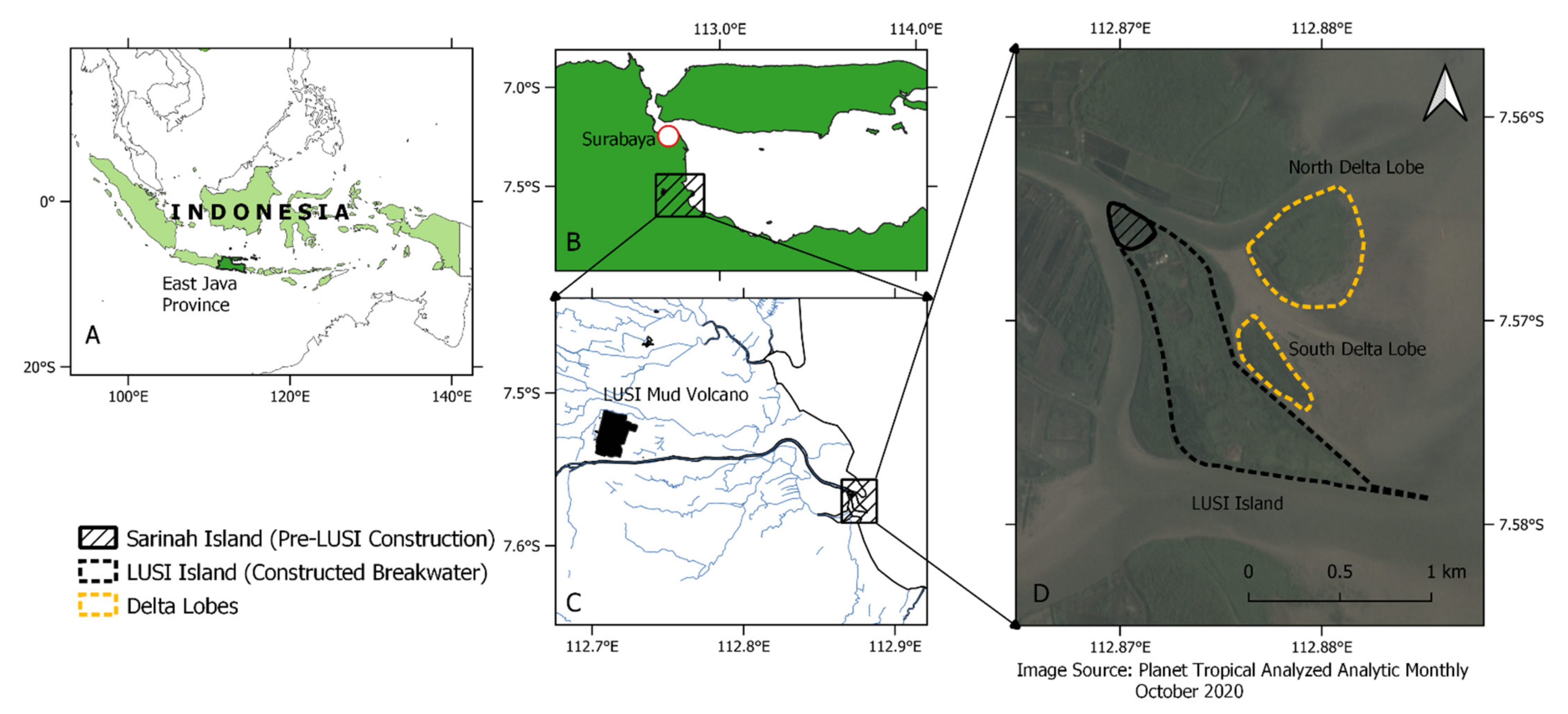
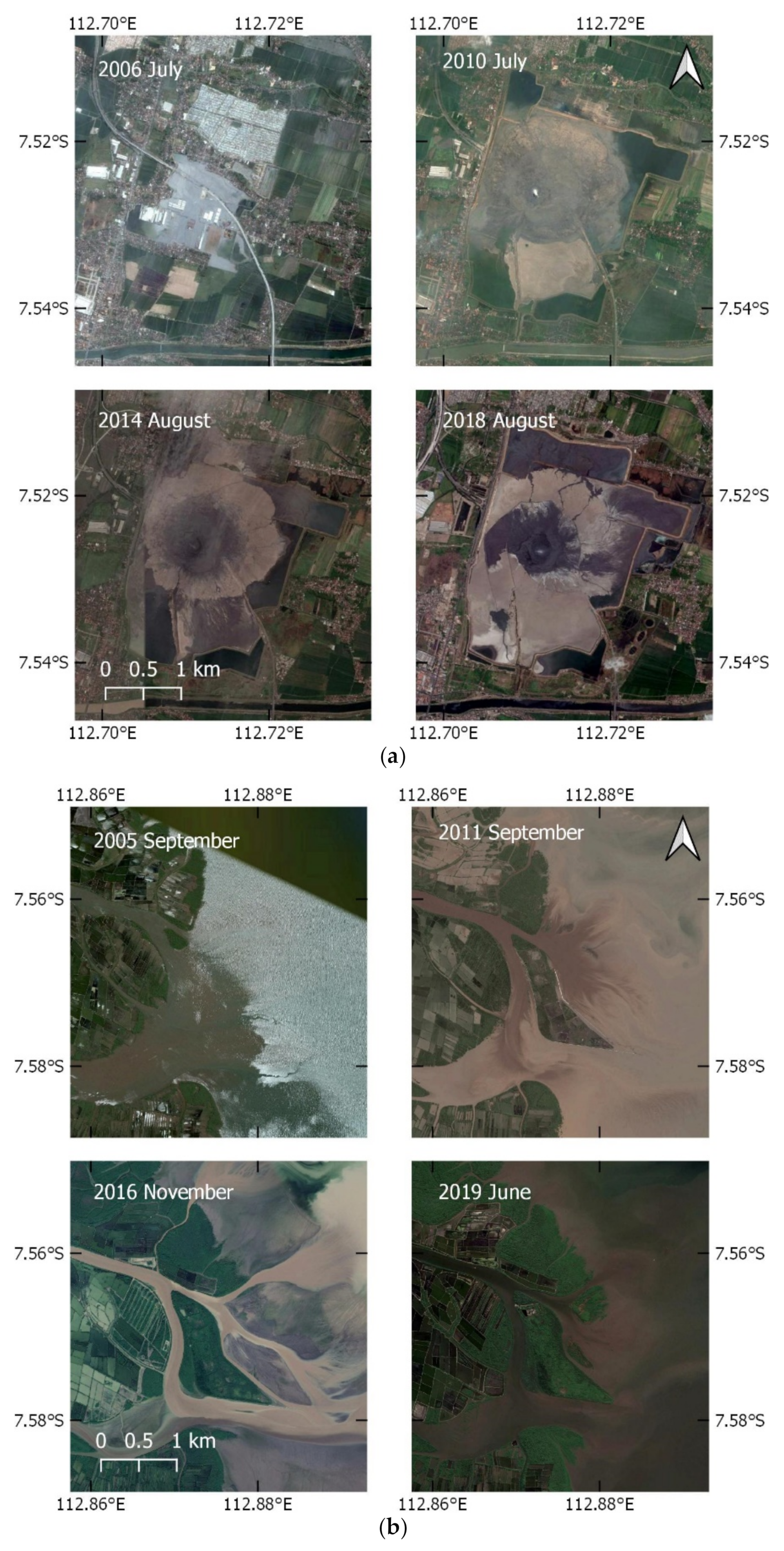
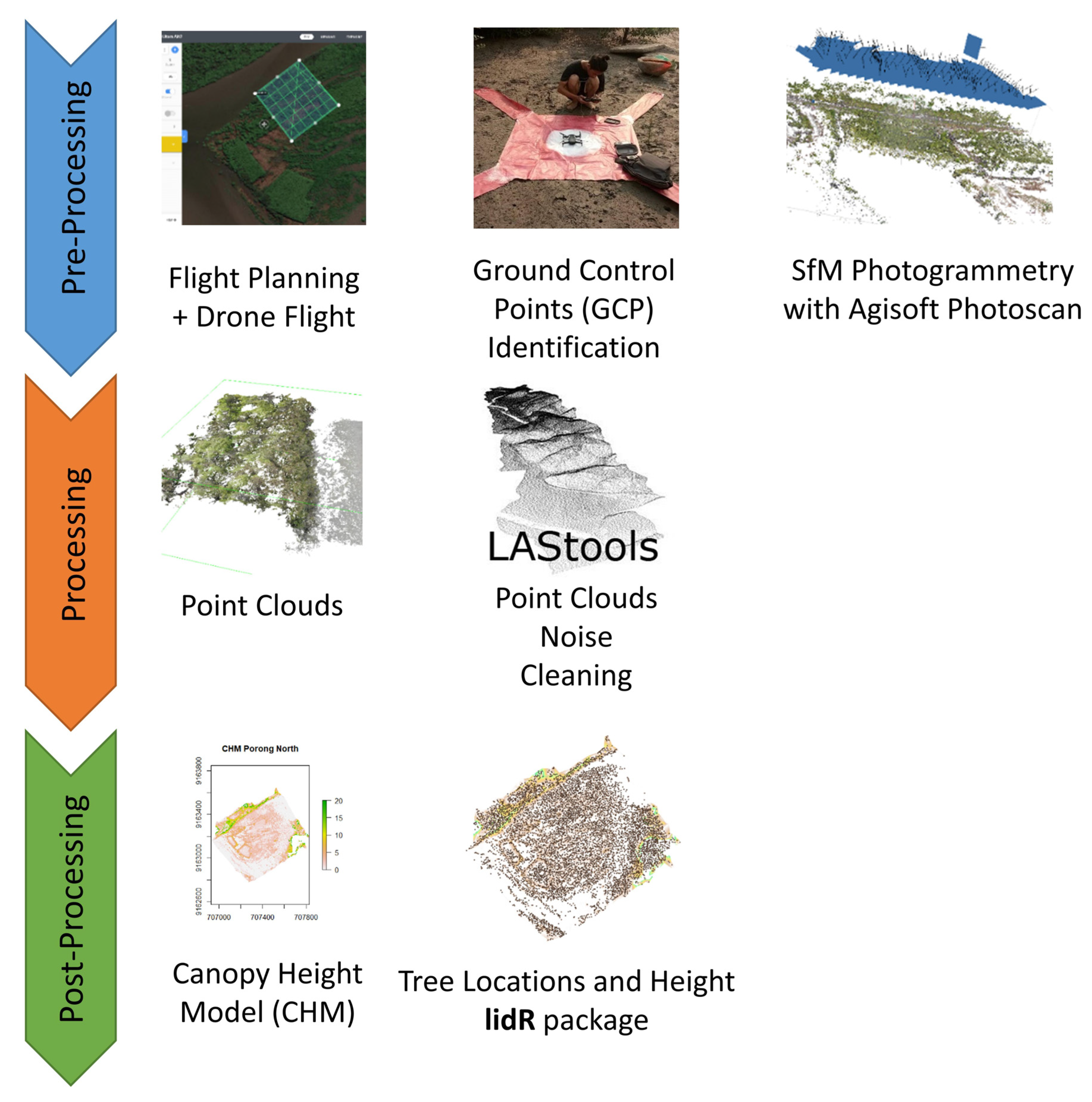

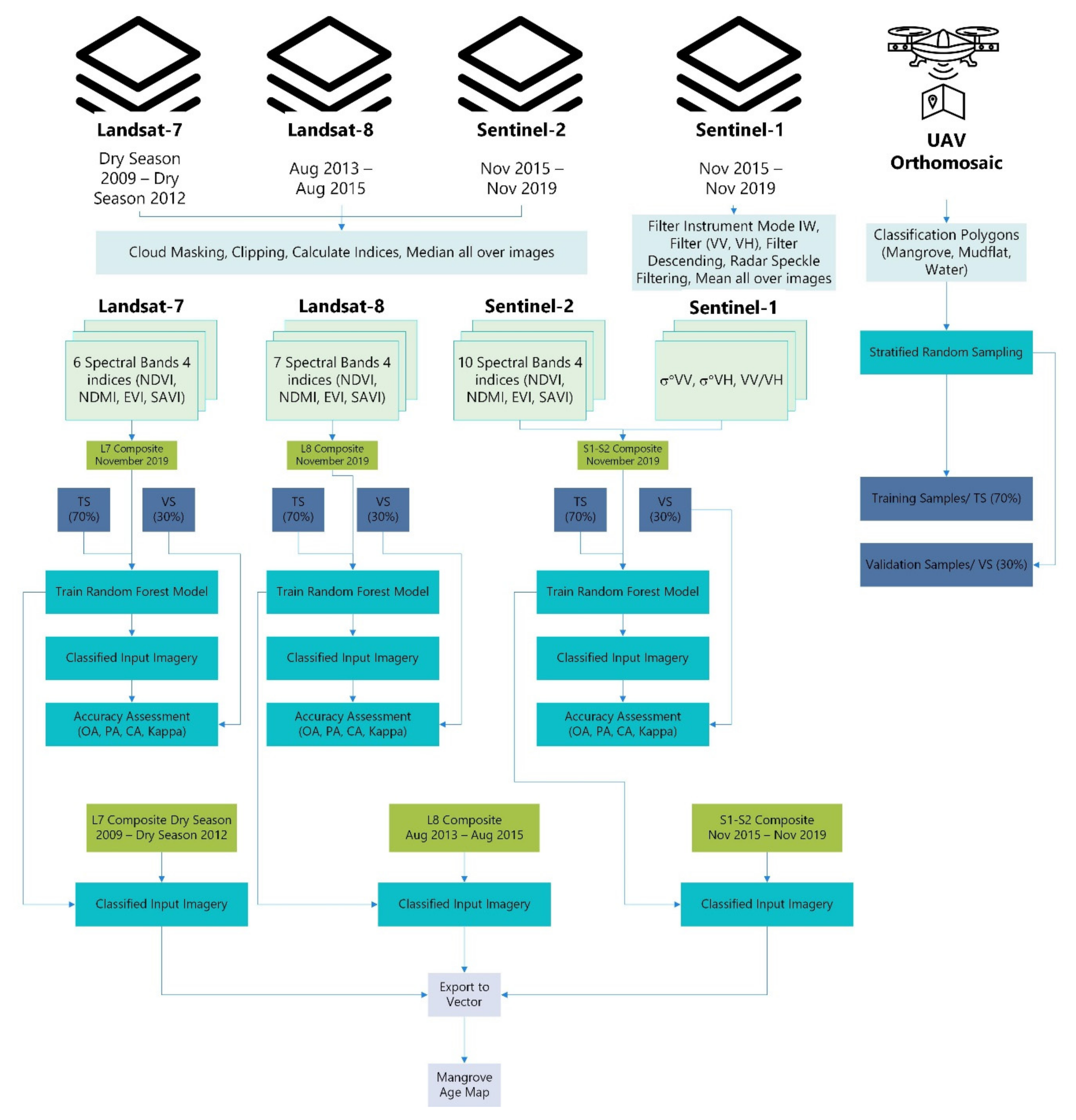

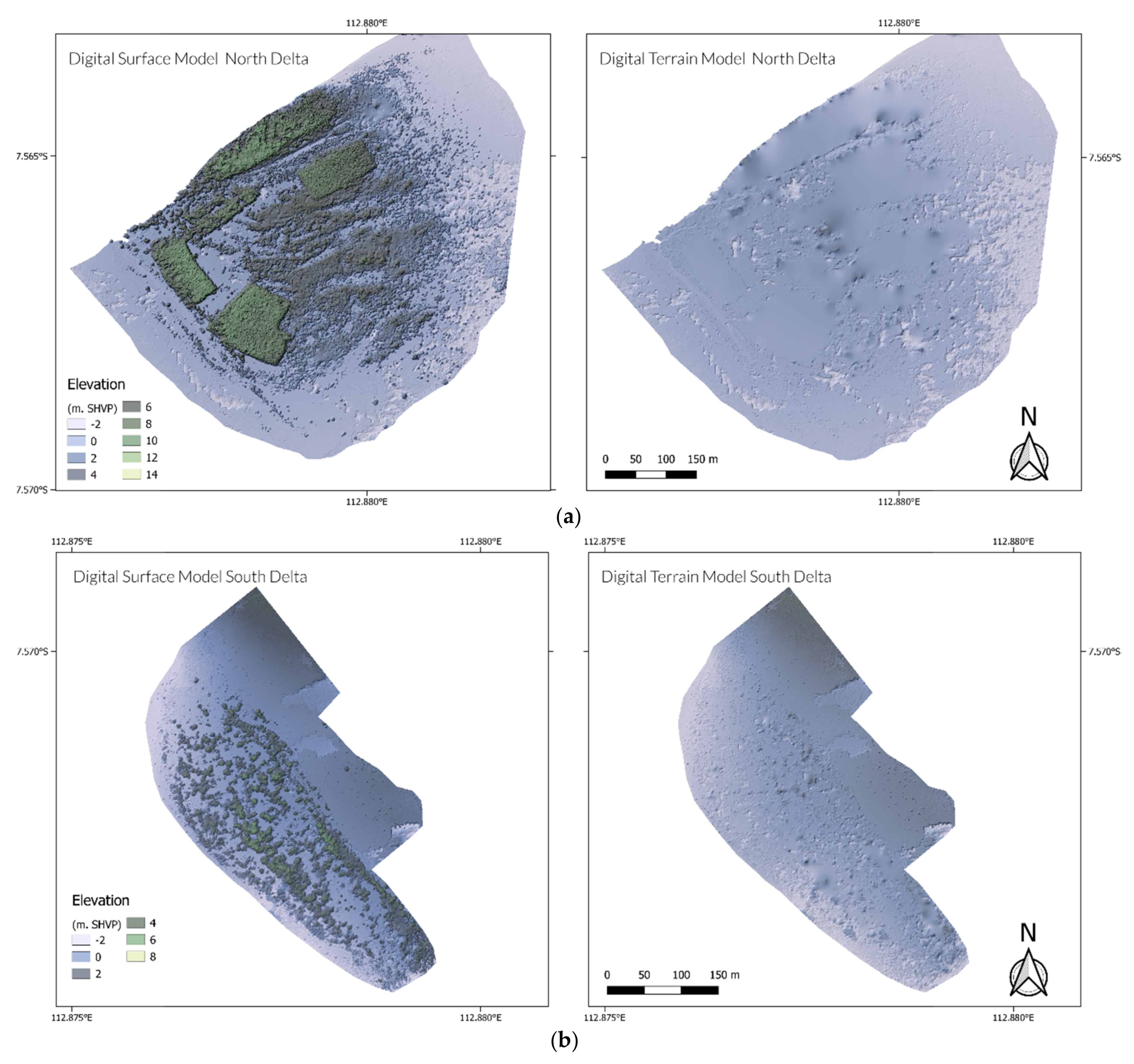

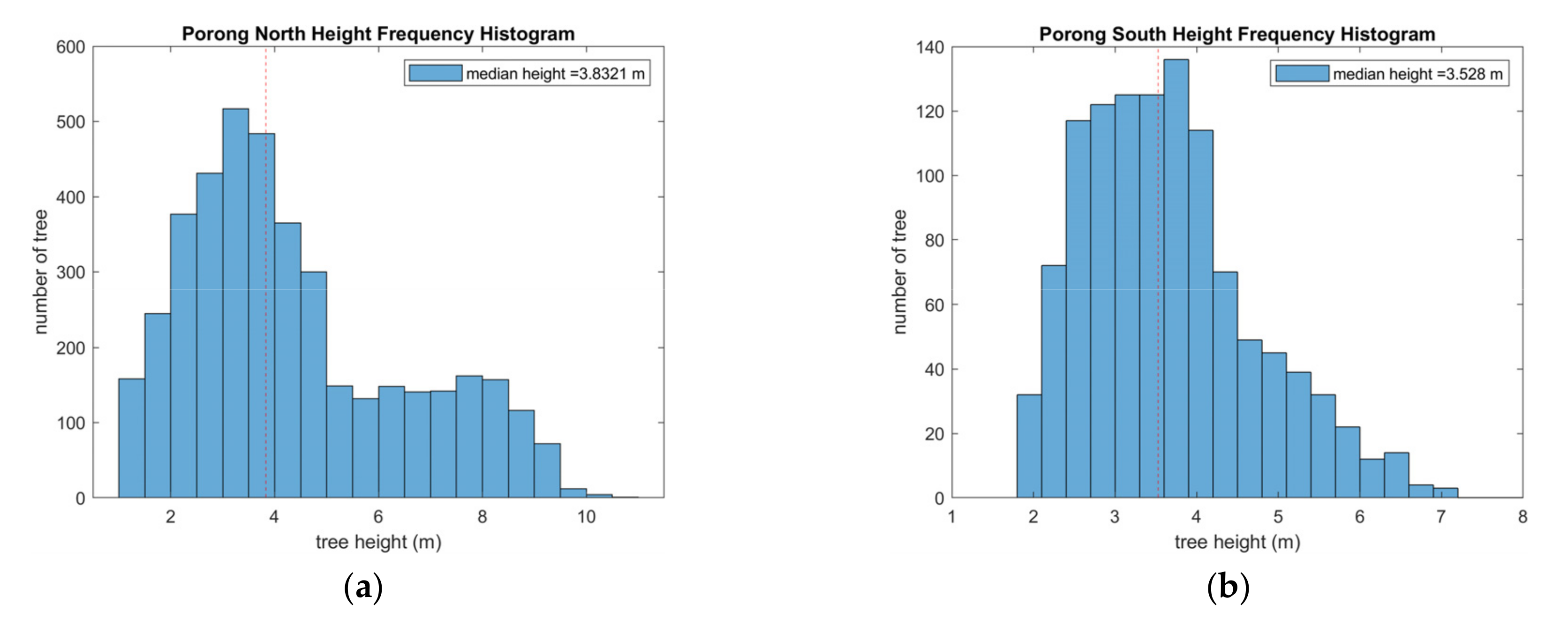
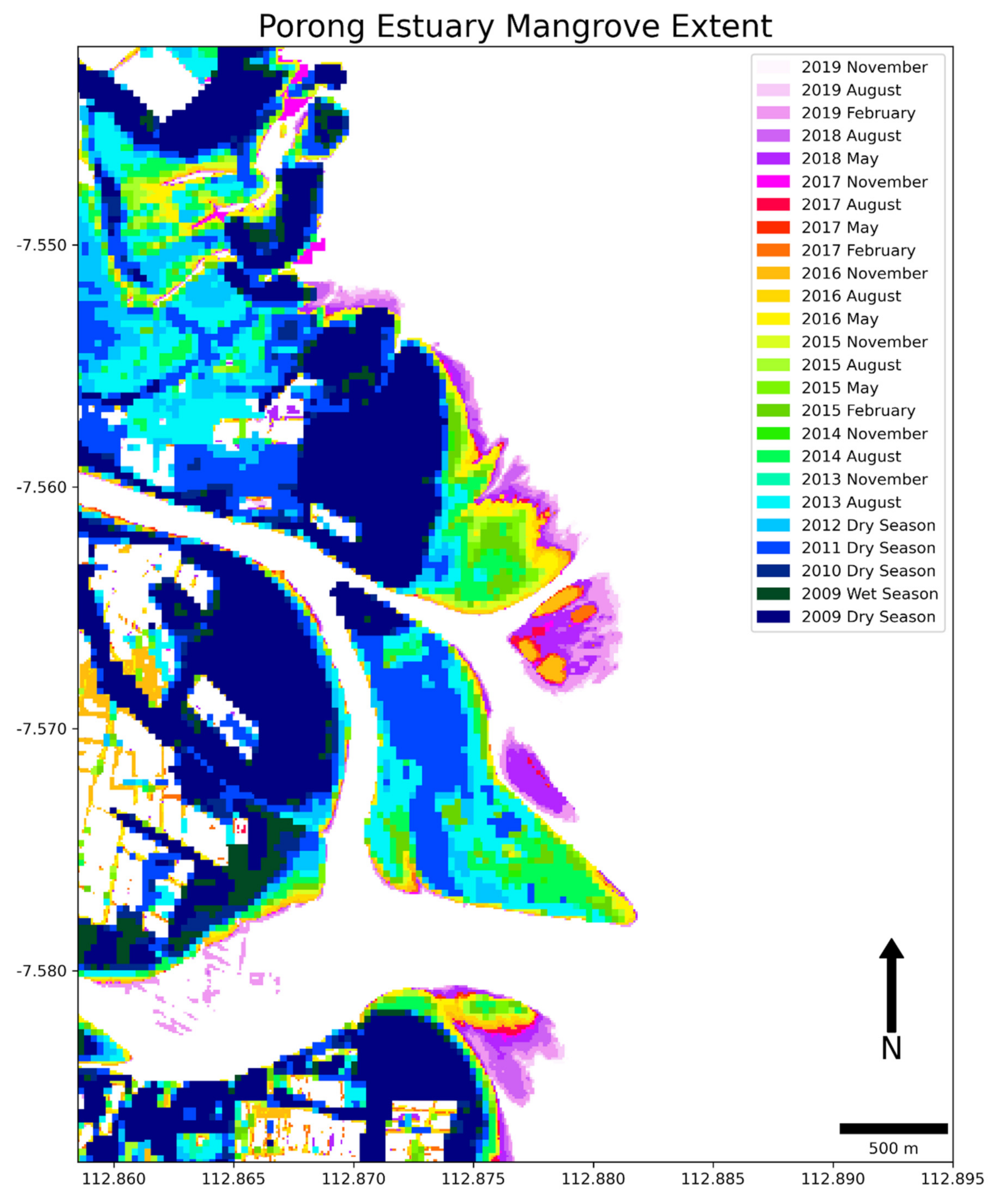

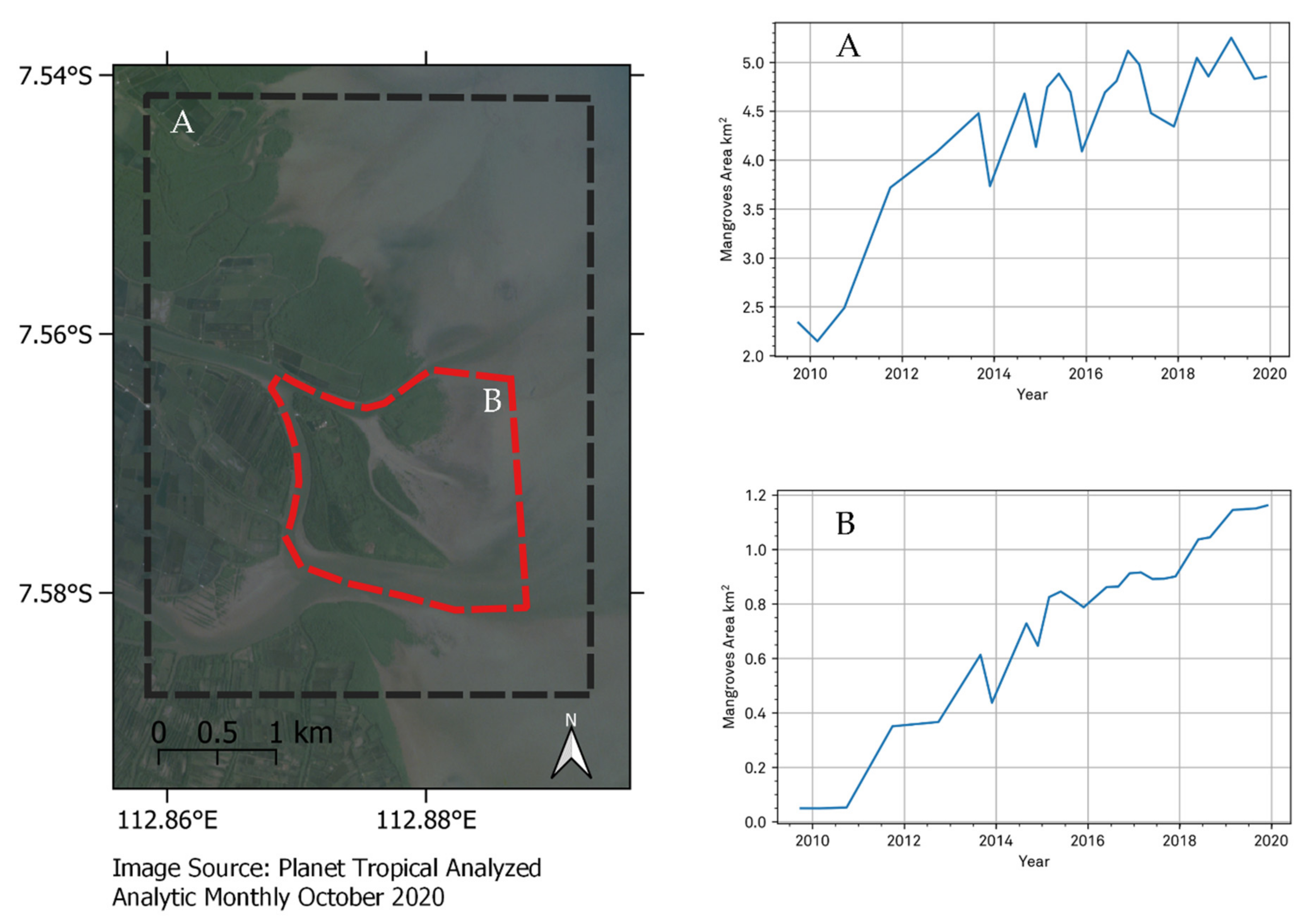
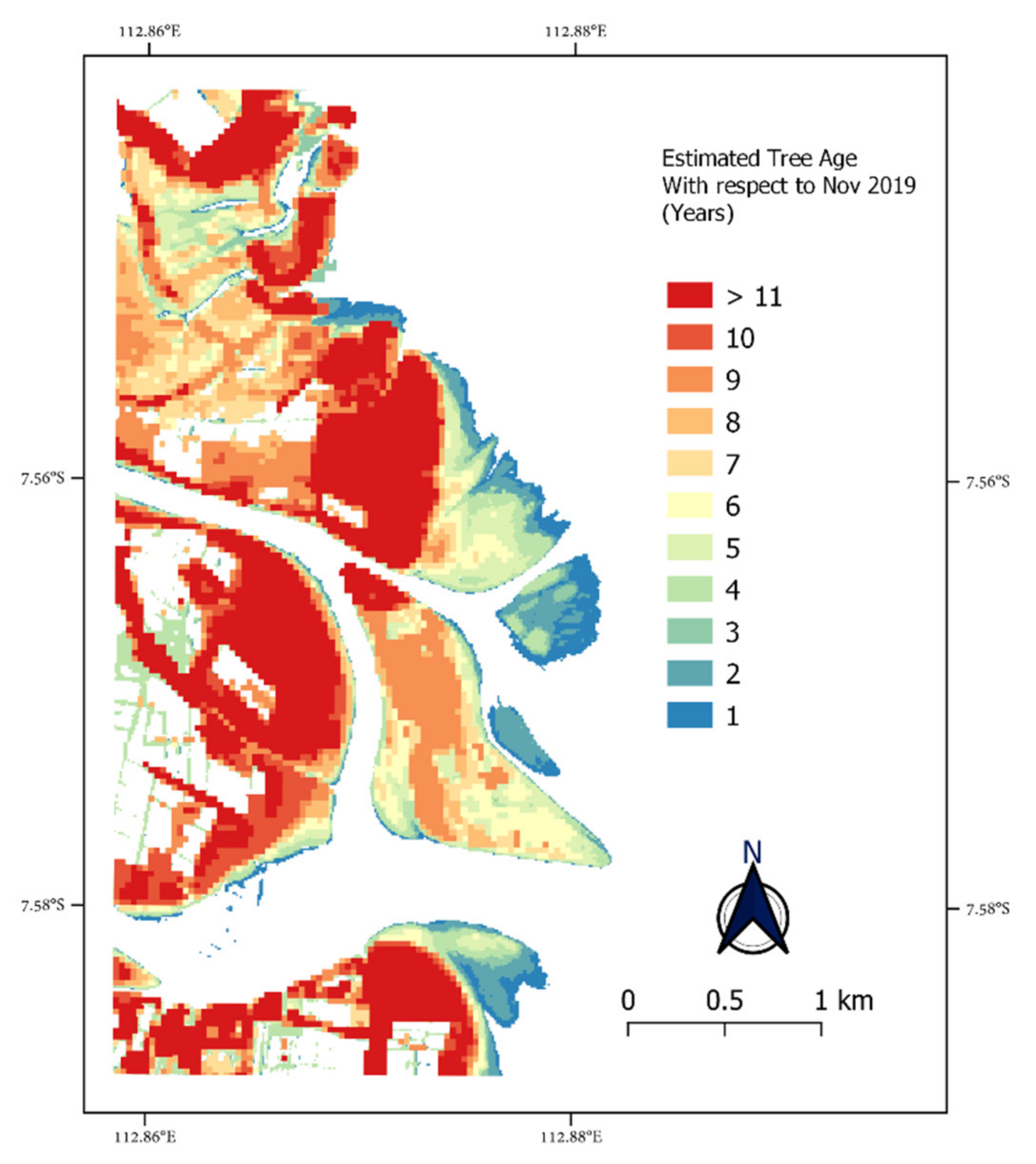
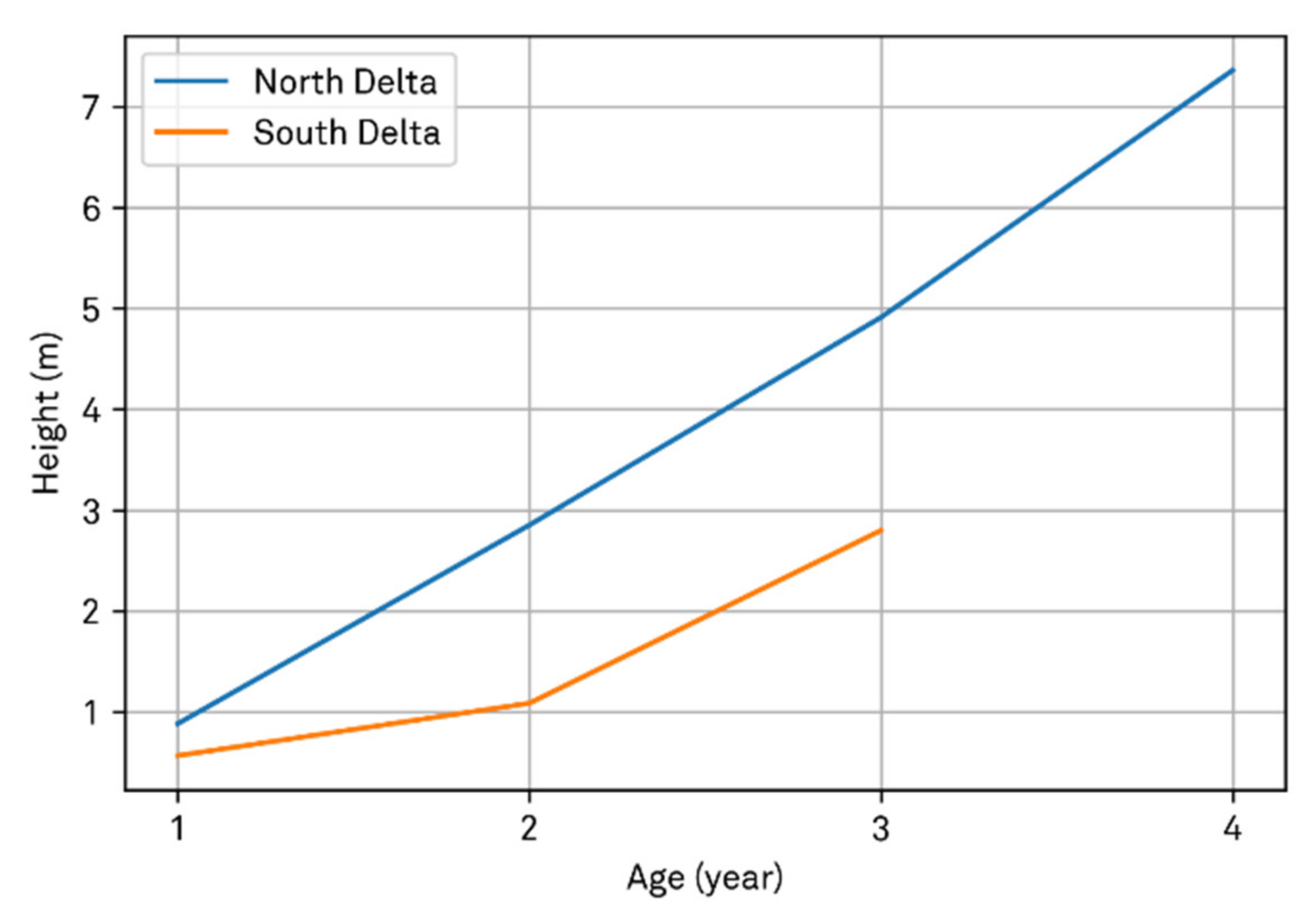
| Mission | Bands/Indices | Metric |
|---|---|---|
| Sentinel-1 | VV, VH, VV/VH | mean |
| Sentinel-2 | B2-B8, B8A, B11-12, NDVI, NDMI, EVI, SAVI | median |
| Landsat-7 | B1-5, B7, NDVI, NDMI, EVI, SAVI | median |
| Landsat-8 | B2-8, NDVI, NDMI, EVI, SAVI | median |
| Indices | Formulas | S-2 | L-7 | L-8 |
|---|---|---|---|---|
| NDVI | (NIR − R) ÷ (NIR + R) | (B8 − B4) ÷ (B8 + B4) | (B4 − B3) ÷ (B4 + B3) | (B5 − B4) ÷ (B5 + B4) |
| NDMI | (NIR − SWIR) ÷ (NIR + SWIR) | (B8 − B11) ÷ (B8 + B11) | (B4 − B5) ÷ (B4 + B5) | (B5 − B6) ÷ (B5 + B6) |
| EVI | 2.5 × ((NIR − R) ÷ (NIR + 6 × R − 7.5 × B + 1) | 2.5 × ((B8 − B4) ÷ (B8 + 6 × B4 − 7.5 × B2 + 1) | 2.5 × ((B4 − B3) ÷ (B4 + 6 × B3 − 7.5 × B1 + 1) | 2.5 × ((B5 − B4) ÷ (B5 + 6 × B4 − 7.5 × B2 + 1) |
| SAVI | (NIR − R) × 1.5 ÷ (NIR + R + 0.5) | (B8 − B4) × 1.5 ÷ (B8 + B4 + 0.5) | (B4 − B3) × 1.5 ÷ (B4 + B3 + 0.5) | (B5 − B4) × 1.5 ÷ (B5 + B4 + 0.5) |
Publisher’s Note: MDPI stays neutral with regard to jurisdictional claims in published maps and institutional affiliations. |
© 2021 by the authors. Licensee MDPI, Basel, Switzerland. This article is an open access article distributed under the terms and conditions of the Creative Commons Attribution (CC BY) license (http://creativecommons.org/licenses/by/4.0/).
Share and Cite
Beselly, S.M.; van der Wegen, M.; Grueters, U.; Reyns, J.; Dijkstra, J.; Roelvink, D. Eleven Years of Mangrove–Mudflat Dynamics on the Mud Volcano-Induced Prograding Delta in East Java, Indonesia: Integrating UAV and Satellite Imagery. Remote Sens. 2021, 13, 1084. https://doi.org/10.3390/rs13061084
Beselly SM, van der Wegen M, Grueters U, Reyns J, Dijkstra J, Roelvink D. Eleven Years of Mangrove–Mudflat Dynamics on the Mud Volcano-Induced Prograding Delta in East Java, Indonesia: Integrating UAV and Satellite Imagery. Remote Sensing. 2021; 13(6):1084. https://doi.org/10.3390/rs13061084
Chicago/Turabian StyleBeselly, Sebrian Mirdeklis, Mick van der Wegen, Uwe Grueters, Johan Reyns, Jasper Dijkstra, and Dano Roelvink. 2021. "Eleven Years of Mangrove–Mudflat Dynamics on the Mud Volcano-Induced Prograding Delta in East Java, Indonesia: Integrating UAV and Satellite Imagery" Remote Sensing 13, no. 6: 1084. https://doi.org/10.3390/rs13061084
APA StyleBeselly, S. M., van der Wegen, M., Grueters, U., Reyns, J., Dijkstra, J., & Roelvink, D. (2021). Eleven Years of Mangrove–Mudflat Dynamics on the Mud Volcano-Induced Prograding Delta in East Java, Indonesia: Integrating UAV and Satellite Imagery. Remote Sensing, 13(6), 1084. https://doi.org/10.3390/rs13061084









